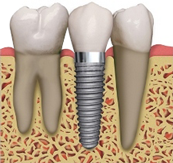
SUV Dental Service
Dental implants are artificial tooth replacements used to replace a missing tooth or teeth, helping to stop or prevent jaw bone loss. The dental implant procedure is categorized as a form of prosthetic (artificial replacement) dentistry, though it also is a form of cosmetic dentistry.
By replacing missing tooth roots, implants offer more than an esthetic enhancement, providing people with the strength and durability required to eat all the foods they love, without struggling to chew. Although you have a number of restorative options for the treatment of missing teeth, none have proven to be as functionally effective and durable as implants.
In many cases, dental implants may be the only logical choice for the restoration of all necessary functionality of the teeth and supporting structures.
Dental Implants Consultation and Treatment Planning
To determine if implants are right for you, a consultation with your dentist, oral surgeon, and/or periodontist or prosthodontist is needed. During this appointment, your dental professional will conduct a thorough examination of your teeth and gums. This may involve a combination of X-rays and computer tomography scans (CT scans) to ensure that sufficient bone structure exists for placing the implant(s), and to determine the exact location the implant should be placed.
Based on the condition of your oral tissues, oral hygiene and personal habits, and your commitment to follow your dentist’s aftercare instructions, your dentist will advise you of your most appropriate dental implant treatment plan. Some patients with insufficient bone or gum tissue require bone or soft tissue grafts, and/or the use of small diameter implants (also called mini implants).
Your treatment plan could involve the immediate placement of an implant and restoration at the same appointment, or require separate procedures to place the implant, allow healing and then place the restoration. In some instances, a series of procedures may be required to place tissue and bone grafting materials, allow time for healing, place the implant and allow it to integrate with your bone, and then place the restoration. Depending on your situation, your dental professional will advise you of how long the entire treatment process will take, how many appointments will be necessary and what you can expect after each procedure.
The consultation also will include discussion of options for local anesthesia (to numb the affected and surrounding areas) and sedation dentistry, if necessary.
The Dental Implant Procedure
To determine if implants are right for you, a consultation with your dentist, oral surgeon, and/or periodontist or prosthodontist is needed. During this appointment, your dental professional will conduct a thorough examination of your teeth and gums. This may involve a combination of X-rays and computer tomography scans (CT scans) to ensure that sufficient bone structure exists for placing the implant(s), and to determine the exact location the implant should be placed.
Today’s dental implants are virtually indistinguishable from other teeth. This appearance is aided in part by the structural and functional connection between the dental implant and the living bone. Implants are typically placed in a single sitting but require a period of osseointegration.
Osseointegration is the process by which direct anchorage of a dental implant root and the bone of the jaw occurs. Osseointegrated implants are the most commonly used and successful type of dental implant. An osseointegrated implant takes anywhere from three to six months to anchor and heal, at which point your dentist can complete the procedure with the placement of a crown. Once the implant has anchored with the jawbone, artificial prosthesis may be attached and the process is done. If osseointegration does not occur, the implant will fail.
Detailed procedural steps are as follows:
Preparing the Jaw for Implantation: A dental implant restoration is commonly composed of a titanium material screw and a crown. A small-diameter hole (pilot hole) is drilled at edentulous (where there is no tooth) jaw sites in order to guide the titanium screw that holds a dental implant in place. To avoid damaging vital jaw and face structures like the inferior alveolar nerve in the mandible (lower jaw), a dentist must use great skill and expertise when boring the pilot hole and sizing the jaw bone.
Placement of the Implant: After the initial pilot hole has been drilled into the appropriate jaw site, it is slowly widened to allow for placement of the implant screw. Once in place, surrounding gum tissue is secured over the implant and a protective cover screw is placed on top to allow the site to heal and osseointegration to occur. After up to six months of healing, your dentist will uncover the implant and attach an abutment (which holds the crown or tooth-like replacement) to the implant. In some cases, the abutment may be attached during the initial procedure. When the abutment is in place, your dentist then will create a temporary crown. The temporary crown serves as a template around which the gum grows and shapes itself in a natural way. The process is completed when the temporary crown is replaced with a permanent crown.
Dental Implants Recovery and Aftercare
Dental implant recovery depends on a number of factors, including the various procedures required to complete your treatment. However, it is generally recognized that once an implant has been placed, maintaining diligent oral hygiene habits is required to ensure proper fusing of the implant and bone structure. Failure to floss and brush is a leading cause of implant failure, and infection can occur if the implant and surrounding areas are not cleaned properly. Smoking also is attributed to high failure rates with dental implants and should be avoided following implant procedures.
When dental implants are used to support crown restorations (like individual teeth), the entire treatment procedure may take anything from three to nine months to complete.
Healing from the surgical procedure to place the dental implant(s) takes up to six months, while the fitting and seating of the crown(s) can take up to two months. Again, this timeframe depends on individual cases and treatments. Follow-up appointments with your treatment coordinators are essential for monitoring your progress. Additionally, even after the abutment and crown, bridge or implant-supported denture have been placed, routine follow-up appointments and cleanings still are required with your dentist and hygienist to ensure the longevity of your treatment.
If cared for properly, an implant restoration can remain in place for more than 40 years. It is generally recognized that once an implant has been placed, maintaining diligent oral hygiene habits is required to ensure proper fusing of the implant and bone structure. Failure to floss and brush is a leading cause of implant failure, and infection can occur if the implant and surrounding areas are not cleaned properly.
Implant Surgery Follow-up Care
After the initial surgical procedure, discomfort should be minimal. Swelling of your gums and face may occur, as well as minor bleeding and bruising of the implant site. Prescription pain medications may be prescribed by your dentist to relieve any pain or discomfort you feel after the procedure.
For five to seven days after surgery, your diet should be restricted to soft foods. If stitches are present, they may need to be removed by your dentist; however, self-dissolving stitches that do not require removal are typically used.
If provisional restorations were placed along with the dental implant, it will be important to clean them as you would your natural teeth to ensure the best possible healing and fusing of the implant.
